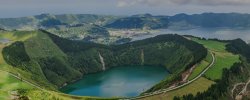
|
All known life on Earth lives on the surface crust - a relatively thin solid layer that floats upon the mantle - a huge mass of molten rock which makes up 84% of the planet’s volume. What the mantle is made of determines the composition of the Earth’s crust, so it is not surprising that much effort has been made to discover exactly what this composition is. The problem is that one can’t just go and take a sample of the mantle - even the top layer is too deep, and far too hot. So scientists wanting to find out about the molten world beneath us have had to try other techniques. |
|
|
The obvious candidate for analysis is magma. Magma is liquid rock which originates in the lower part of the Earth’s crust and in the upper portion of the mantle. On occasion, magma comes to the surface through volcanic action. One thing that scientists have determined from the study of magma is that it appears that the mantle is not a single homogenous mass in which all the ingredients have been thoroughly mixed together. Magma composition differs in different regions. Depending on where it bubbles up through the crust we get differences in the amounts of molten rock versus gas content, and magma of different viscosity and temperature. These last two factors greatly depend on the percentage of silica (the most abundant constituent of rocks and minerals) in the magma. Low silica magma is fluid, and usually erupts non-explosively, as quick-flowing lava which turns to basalt after it cools down. Thick, viscous felsic magma which traps gas in the magma chamber and this gas can cause highly explosive eruptions. This lava gives rise to rhyolite volcanic rocks. Continental drift often brings magma to the ocean floor and creates oceanic crust and this crust contains a residual material from the mantle, though the chemical composition becomes depleted over time. The condition of the original mantle is generally inferred from basalts produced in mid-ocean ridges. However, isotopic differences between oceanic mantle rocks and mid-ocean ridge basalts suggest that mantle and basalt might be rather different things, so what we thought we knew about the mantle needs to be re-examined. Recently geochemists from the University of Munster (Germany) and Amsterdam led by Prof. Andreas Stracke carried out studies of volcanic rocks that have built up to form the Portuguese island group of the Azores. Their work focused on quantifying the concentration of so-called incompatible elements in rock to see what this can tell them about the mantle from which it originated. In geochemistry an incompatible element is one which is unable to create a stable bond with the minerals in which it is included. This can be because of the element's size or electron charge. As magma is created, elements that have difficulty combining with the mineral elements are concentrated in the melt phase of magma (liquid phase). Among the incompatible elements are LREE, the 'light rare-earth elements' - lanthanum (La), cerium (Ce), praseodymium (Pr), neodymium (Nd) and samarium (Sm). Rocks or magmas that are rich in light rare-earth elements are referred to as "fertile", and those with little LREE are referred to as "depleted". To gain insight into the mantle composition and the concentration of LREE, the group studied samples of olivine collected from volcanic sites. Olivine is also an abundant mineral in the lower portion of many ophiolites. (Slabs of oceanic crust with part of the upper mantle attached that have been thrust up onto an island or a continent.) Olivine crystallizes at a higher temperature than most other minerals and is therefore one of the first minerals to crystallize from magma. In a cooling magma chamber, crystals of olivine may form. Being denser than liquid rock, they settle to the bottom. Analysing material trapped in olivine crystals should give important information about the mantle. The group from the University of Munster was particularly interested in the concentration of the LREE neodymium. Using highly sensitive mass spectrometers, the researchers analysed the isotopic composition of melts extracted from olivine crystals. "Owing to the high efficiency of our measurements, we were able to analyse the isotopic composition of one billionth of a gram of the element [neodymium]" said Dr. Felix Genske, a co-author of the recently published results. (Dr. Felix Genske works in the Institute of Mineralogy at the University of Münster's and was the one who carried out most of the analytical work.) These results revealed that the composition of the mantle below the Azores is not as previously thought - and analysis of the samples suggests that large parts of the mantle here contain surprisingly few incompatible elements, making the mantle underneath the Azores more depleted than expected. "On the basis of similar geochemical data in volcanic rocks from different regions, e.g. Hawaii, other parts of the Earth's mantle may also contain a higher proportion of material that is strongly depleted in incompatible elements," said Prof Stracke. The scientists concluded that because Earth's crust is rich in incompatible elements, this global deficit of rare-earth elements in the mantle may be compensated by the recycling of Earth's crust back into the mantle as continental plates overlap. They hope to continue their research by investigating samples from other volcanic islands across the globe. Journal Reference: | |
| _______________________________ | ||||
| Home | | | Shopping | | | Database |
© Biscuit Software 2004-2019
All rights reserved